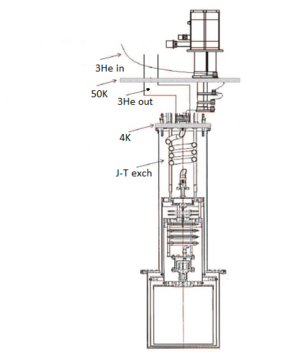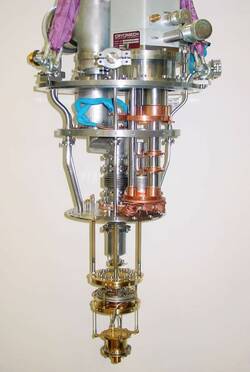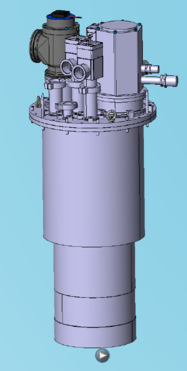Pulse-tube pre-cooled dilution units
First machines
The first pulse-tube pre-cooled dilution units were developed simultaneously in Japan, Germany and France in the late 90's, in research and industrial environments, when efficient pulse-tube cryocoolers became available.
Koike's Lab
A 41 mK hybrid refrigerator (Gifford - McMahon and pulse-tube) was built very early in Japan. The pulse-tube was used as 4K stage, making this machine a genuine pulse-tube based dilution unit. The performance was poor, however, due to the Gifford - McMahon high temperature stage.
- A dilution refrigerator using the pulse tube and GM hybrid cryocooler for neutron scattering, Y. Koike, Y. Morii, T. Igarashi, M. Kubota, Y. Hiresaki, K. Tanida, Cryogenics 39 (1999) 579-583, https://doi.org/10.1016/S0011-2275(99)00077-6
Uhlig's Lab
Kurt Uhlig, in Garching, developed several machines of increasing performance. The first refrigerator reached 15 mK with a continuous heat exchanger (2002). A new model with a double mixing-chamber reached 4.3 mK (2004). A different machine with step heat exchangers allowed reaching T<10 mK (2012):
- 3He/4He dilution refrigerator with pulse-tube refrigerator precooling, Kurt Uhlig, Cryogenics 42 (2002) 73–77, https://doi.org/10.1016/S0011-2275(02)00002-4
- “Dry” dilution refrigerator with pulse-tube precooling, Kurt Uhlig, Cryogenics 44 (2004) 53, https://doi.org/10.1016/j.cryogenics.2003.07.007
- Cryogen-free dilution refrigerators, K Uhlig 2012, Journal of Physics:Conference Series 400 (2012) 052039 https://doi.org/10.1088/1742-6596/400/5/052039
Godfrin's Lab
 A commercial pulse-tube dilution refrigerator was developed in 1999 in Grenoble (France) by H. Godfrin and Ch. Gianèse (CNRS) and the company l'Air Liquide. The first commercial machine (PT-DR1, picture on the right) was delivered to A. Giuliani (Cuoricino experiment) in 2003. With 4 sintered silver heat exchangers, the refrigerator had a base temperature of 5 mK. Because of patents and industrial know-how agreements, details were published later:
A commercial pulse-tube dilution refrigerator was developed in 1999 in Grenoble (France) by H. Godfrin and Ch. Gianèse (CNRS) and the company l'Air Liquide. The first commercial machine (PT-DR1, picture on the right) was delivered to A. Giuliani (Cuoricino experiment) in 2003. With 4 sintered silver heat exchangers, the refrigerator had a base temperature of 5 mK. Because of patents and industrial know-how agreements, details were published later:
- Pulse-tube dilution refrigeration below 10 millikelvins, T. Prouvé, H. Godfrin, C. Gianèse, S. Triqueneaux, A. Ravex, J. of Low Temp. Phys. 148 (5-6), 909-914 (2007) https://doi.org/10.1007/s10909-007-9450-6
- Pulse-tube dilution refrigeration below 10 mK for Astrophysics; T. Prouvé, H. Godfrin, C. Gianèse, S. Triqueneaux, A. Ravex, J. of Low Temp. Phys. 151, 640-644 (2008), https://doi.org/10.1007/s10909-008-9725-6
- Experimental results on the free cooling power available on 4K pulse tube coolers, T. Prouvé, H. Godfrin, C. Gianèse, S. Triqueneaux, A. Ravex, J. of Phys. : Conference Series 150, 012038 (2009). https://doi.org/10.1088/1742-6596/150/1/012038 (Air Liquide, U.S. Patent 6,915,642; CNRS-Air Liquide French Patent FR07 53945)
- Développement d'un réfrigérateur à dilution prérefroidi par un tube à gaz pulsé, Thomas Prouvé, PhD Thesis, Grenoble (2007) https://tel.archives-ouvertes.fr/tel-00201891
The cryostats PT-DR1 (industrial version version delivered in 2003), PT-DR2 (2007, version presented at the Industrial Exhibition of LT25, Amsterdam, 2008), and PT-DR4 (Pulse-tube dilution for neutron scattering, 2021 version shown):


